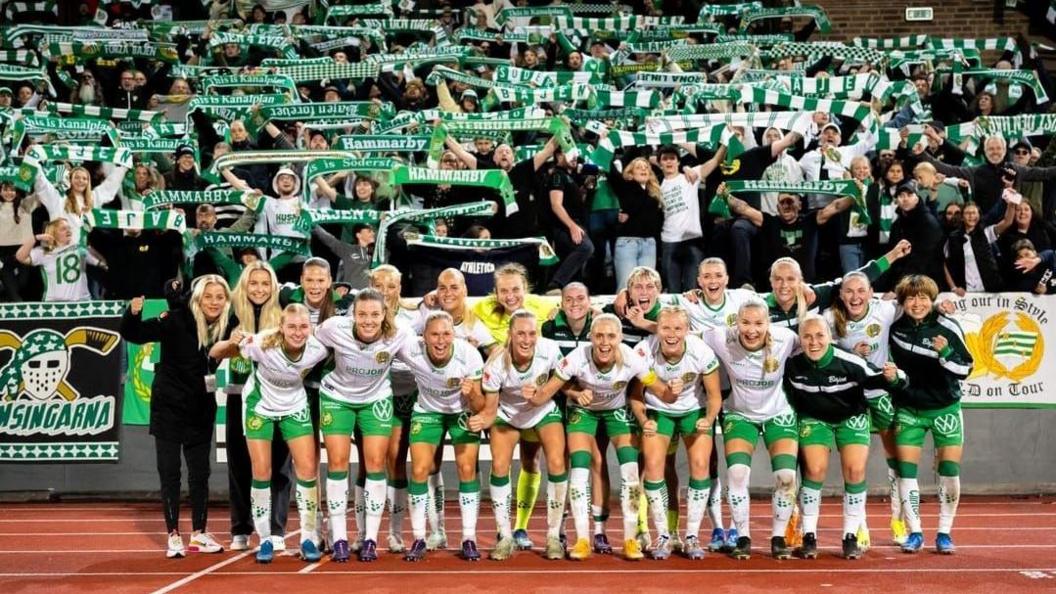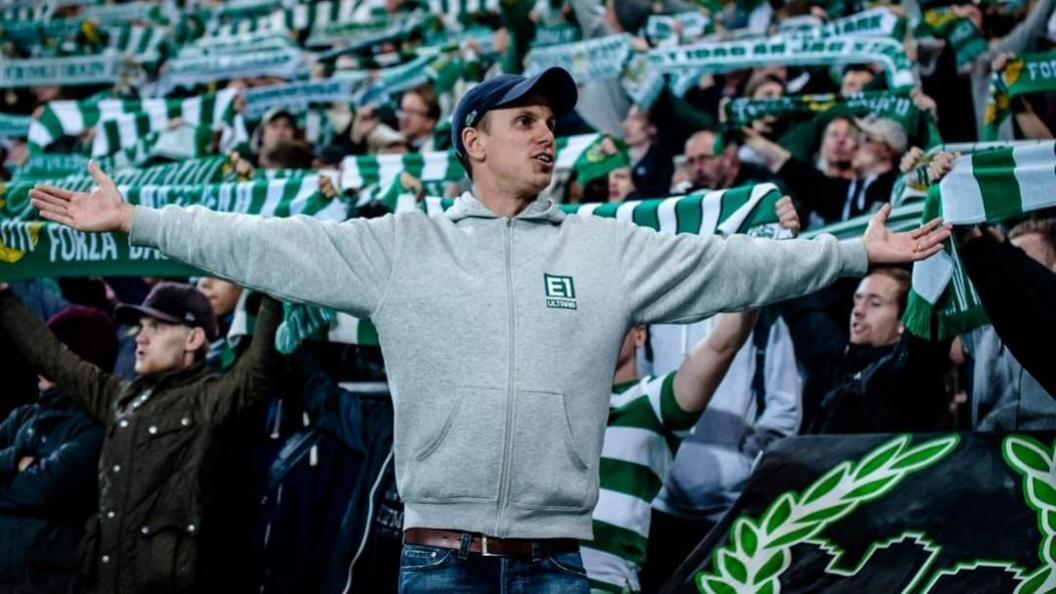Tifo and ultras in women's football - the Swedish fans heading to Manchester

Hammarby have broken several attendance records in recent years
- Published
When Manchester City host Hammarby in the Women’s Champions League on Tuesday, home supporters at the Joie Stadium might be surprised by what they see.
Whether Hammarby are playing at their modest Kanalplan home in the Sodermalm district of Stockholm, at the capital's 28,000-capacity Tele2 Arena, up and down Sweden or even overseas, they receive the kind of support rarely seen in women’s football.
Their 9-0 defeat by Barcelona on matchday two made headlines, but on social media it was photos and videos of the travelling Hammarby fans that gained the most traction.
About 350 Bajen, as Hammarby supporters are known, packed out a corner of the Estadi Johan Cruyff. As the players emerged on to the pitch, the Swedish fans held up a green and white choreography and drowned out their hosts. They did not stop all game.
There will be about 400 away fans in Manchester.
'Let's change that'
Hammarby supporters are showing what the future of women’s football fandom could look like, but it has not always been like that. It all started about 10 years ago when Hammarby fan Ulf Stenback and a group of friends founded the Bajens Tjejtjusare group with the aim of giving the women's team the kind of vocal backing enjoyed by the men.
"In the beginning it was very much the social aspect which was the main reason to go to matches, just like with other sections of the club such as handball or hockey," Hammarby fan Daniel Hommrich tells BBC Sport. But things exploded when Simon Sandstrom got involved.
Sandstrom, a former capo - a fan who leads others in chants - of two Hammarby ultras groups was at a women's game with his young daughter.
"My daughter looked at me with sad eyes and asked: 'Dad, why isn't anyone singing? Why isn't there any drums? This is boring'," Sandstrom remembers. "I felt sad for her and answered without really thinking, 'well, let's change that'."
Sandstrom established the Bajenkompaniet, a supporters' group dedicated to the women's team. At the next home match he jumped up on to the fence surrounding the pitch and conducted his new group, including old-timers like Stenback and former ultras. "We were singing the whole game and after that more and more people joined. Every game we had new men and women joining," he recalls.

Simon Sandstrom promised his daughter he would improve the atmosphere at Hammarby women's games
Things began to snowball, and before long Sandstrom was hosting pre-match pub meetings and organising trips to away games. Two fellow fans created a group charged with making 'tifos', the huge choreographies displayed by fans before kick-off. There had never been anything like that in women’s football.
"I can't find words for how important that has been for the development of Hammarby's supporter culture, and increasing the number of people coming to the women's games. The tifos have been seen all over the world," says Sandstrom.
Over the years that followed, attendances exploded. A breakthrough came in October 2021 when more than 18,500 fans watched Hammarby beat local rivals AIK at Tele2 Arena, home of the Hammarby and Djurgardens men's teams. In June 2023, 17,623 fans attended the Swedish Cup final and witnessed Hammarby end a 28-year trophy drought.
On the final day of last season, more than 7,000 fans made the 300km round trip to see Hammarby beat IFK Norrkoping 2-0, clinching only their second Damallsvenskan title and a place in the Champions League for the first time. Later that day, thousands celebrated the historic achievement at Stockholm's Medborgarplatsen.
'One-club' philosophy

Hammarby fans are travelling to away games in increasing numbers
The growth of support for the women's team has been organic, the product of community building and cooperation on an impressive scale. While supporters have mobilised independently of the club and fund their choreographies, banners and pyro displays, Hammarby's 'one-club' philosophy has certainly helped.
Having joint social media accounts for the men's and women's teams broadened the reach of the latter, while many of the club's sponsors support both sides.
Close collaboration with the club's support liaison officer and ticketing manager has helped grow the supporter base, while referring to the team as Hammarby, rather than Hammarby women, sends the clearest message of all.
"I think in recent years the club has proven that it's an honest philosophy. There's a genuine pride over the team and its development," says Hommrich.
Hammarby on European tour

Captain Alice Carlsson, depicted in the 'tifo', reportedly rejected lucrative contract offers from several European clubs in the summer to stay at Hammarby
While Hammarby failed to defend their league title this season, they are enjoying a new adventure in Europe.
A 12,062 crowd - a record for a WCL qualifier - watched Martin Sjogren's side lose 2-1 at home in the first leg of their play-off against Benfica, quarter-finalists last season.
A week later in Lisbon, Cathinka Tandberg's 95th-minute strike secured a 3-2 aggregate victory and a place in the group stage for the first time.
Before their group-stage debut - a 2-0 win against Austrian side St Polten at the Tele2 Arena - the players were welcomed on to the pitch by a huge tifo showing captain Alice Carlsson planting a Hammarby flag in the centre of a map of Europe.
More than 14,000 tickets have been sold for the home fixtures against Manchester City and Barcelona.
"The backing we have from the stands is unique," midfielder Julie Blakstad said before the trip to Barcelona. "It really helps us in matches, especially knowing many fans travel to support us."
And that is the point of it all, really. What Sandstrom, Hommrich and thousands of other Hammarby fans are doing continues the fight for gender equality in a space that still desperately needs it.
"I have three daughters - I want them to have the same dreams as the boys," says Sandstrom.
"My heart is burning for equality in football. I want the women's teams to play for the same amount of people and I want to have big singing stands with capos, drums and big tifos. In Hammarby, female players can live that dream right now."